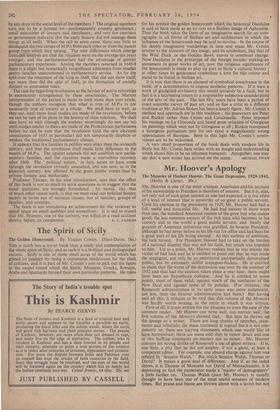The Spirit of Sicily
The Golden Honeycomb. By Vincent Cronin, (Hart-Davis. 16s.) This is much less a travel book than a study and contemplation of the whole spirit of Sicily, and as such it is a brilliant and distinguished success. Sicily is one of those small areas of the world which has gained its potency by being a continuous rendezvous, for the clash of cultures, and it is part of Mr. Cronin's aim to pick out the figure in the carpet round which the Sicels, Minoans, Greeks, Romans, Arabs and Spaniards formed their own particular patterns. He takes for his symbol the golden honeycomb which the historical Daedalus is said to have made as an ex vow to a Sicilian image of Aphrodite. Thus the book takes the form of an imaginative search for an icon- ography in all forms of Sicilian art and architecture in which the influence of the honeycomb may be said to survive. In the course of his deeply imaginative wanderings in time and space Mr. Cronin returns to the leitmotiv of this image, and its symbolism, like that of the Wild Duck or the Golden Bowl, moves in continual change. Now Daedalus is the prototype of the foreign invader making an atonement in great works of art, now the religious significance of the honeycomb is made to play its part in Sicily's cultural history ; at other times its goldenness symbolises a love for this colour and metal to be found in Sicilian art.
It is true that there is an element of symbolical contrivance in the book, of a determination to impose aesthetic patterns. If it were a work of gradgrind art-history this would certainly be a fault, but in fact it is a heartening return to a responsibly subjective consideration of the arts of the past. The last fifty years have been a period of exact scientific survey of past art, and so fine a critic in a different tradition as Mr. Adrian Stokes has been a lonely figure. Mr. Cronin's method and approach are in this tradition ; his precursors are Pater and Ruskin rather than Crowe and Cavalcaselle. Pater imposed his musings on La Gioconda and based great criticism of Giorgione on paintings which were not by Giorgione at all ; Ruskin transposed a bourgeois puritanism into (to our eyes) a magnificently wrong appreciation of Baroque. Seen in this light Mr. Cronin's contri- vances are to be welcomed.
A very small proportion of the book deals with modern life in Sicily but Mr. Cronin here writes with an insight and understanding which shows Him to be no inhuman humanist. ,Altogether, one may say that a new writer has arrived on the scene. MICHAEL SWAN


































 Previous page
Previous page